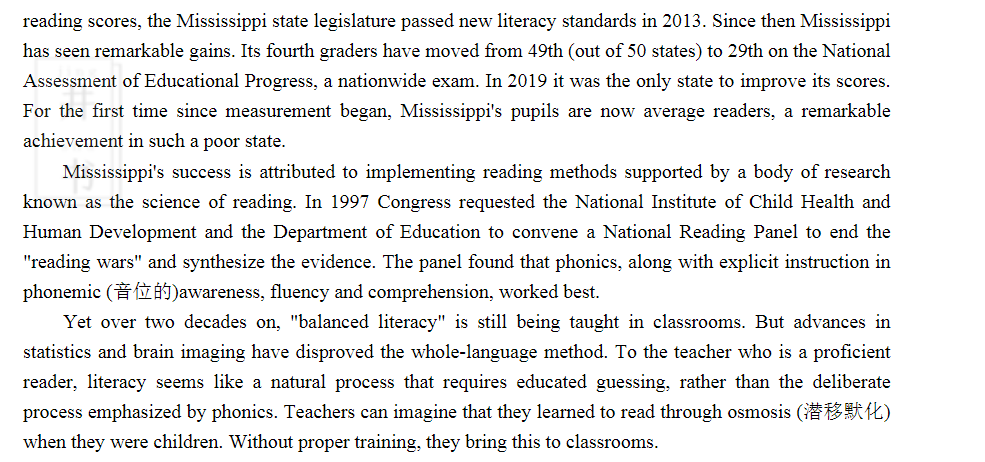QQ扫一扫联系

Passage Two
Questions 51 to 55 are based on the following passage.
Phonics, which involves sounding out words syllable ( 音 节 ) by syllable, is the best way to teach
children to read. But in many classrooms, this can be a dirty word. So much so that some teachers have had
to sneak phonics teaching materials into the classroom. Most American children are taught to read in a way
that study after study has found to be wrong.
The consequences of this are striking. Less than half of all American adults were proficient readers in
2017. American fourth graders rank 15th on the Progress in International Literacy Study, an international
exam.
America is stuck in a debate about teaching children to read that has been going on for decades. Some
advocate teaching symbol-sound relationships (the sound k can be spelled as c, k, ck, or ch), known as
phonics. Others support an immersive approach (using pictures of a cat to learn the word cat), known as
"whole language". Most teachers today, almost three out of four according to a survey by the Ed Week
Research Centre in 2019, use a mix called "balanced literacy". This combination of methods is ineffective.
"You can't sprinkle in a little phonics," says Tenette Smith, executive director of elementary education and
reading at Mississippi's education department. "It has to be systematic and explicitly taught."
Mississippi, often behind in social policy, has set an example here. In a state once notorious for its low

51. What do we learn about phonics in many American classrooms?
A) It is ill reputed. C) It is arbitrarily excluded.
B) It is mostly misapplied. D) It is misrepresented.
52. What has America been witnessing for decades?
A) An obsession with innovating teaching methodologies of reading.
B) An enduring debate over the approach to teaching children to read.
C) An increasing concern with many children's inadequacy in literacy.
D) An ever-forceful advocacy of a combined method for teaching reading.
53. Why does Tenette Smith think a combination of teaching methods is ineffective?
A) Elementary school children will be frustrated when taught with several methods combined.
B) Phonics has to be systematically applied and clearly taught to achieve the desired effect.
C) Sprinkling in a little phonics deters the progress of even adequately motivated children.
D) Balanced literacy fails to sustain children's interest in developing a good reading habit.
54. What does the author say Mississippi's success is attributed to?
A) Convening a National Reading Panel to synthesize research evidence.
B) Placing sufficient emphasis upon both fluency and comprehension.
C) Adopting scientifically grounded approaches to teaching reading.
D) Obtaining support from Congress to upgrade teaching methods.
55. What have advances in statistics and brain imaging proved ineffective?
A) The teaching of symbol-sound relationships. C) Efforts to end the reading wars.
B) Explicit instruction in phonemic awareness. D) The immersive approach.